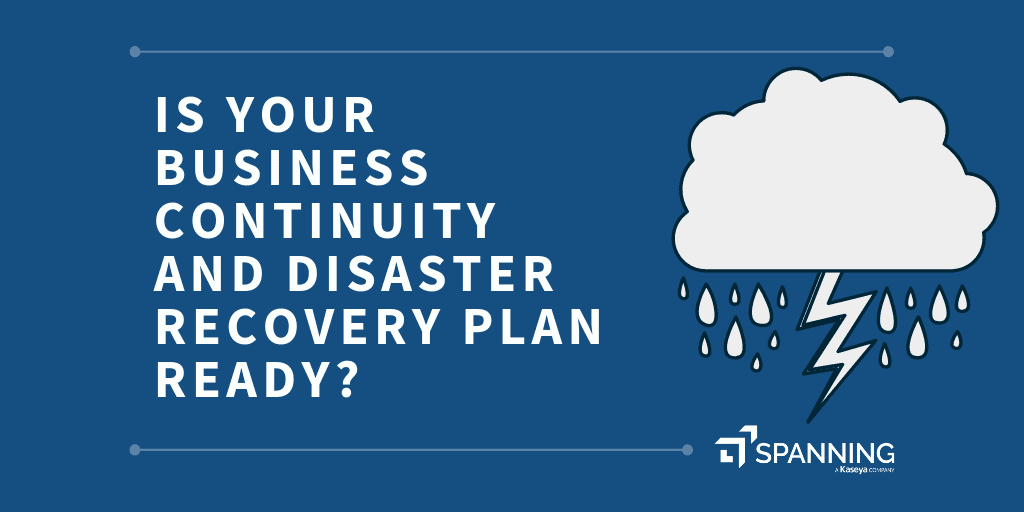Hurricane Season is Upon Us: Is Your Business Continuity and Disaster Recovery Plan Ready?
As the southeastern United States braces for another hurricane season on the heels of the busy 2018 season, it’s a good reminder for all organizations, no matter where they are headquartered, to review their business continuity and disaster recovery plans.
The Small Business Administration (SBA) has published several studies that indicate that the type of catastrophic data loss suffered during a disaster is one of the most detrimental events that can occur to a business. According to the SBA, nearly three-quarters of business owners don’t have a Disaster Recovery (DR) plan, while over 80% don’t have natural disaster insurance and nearly 70% don’t have access to a generator in the event of loss of electricity.

Even more alarming: 25 – 45% of businesses don’t open at all after experiencing a disaster — and close to 70% of those businesses that suffer data loss are forced to go out of business within two years of the disaster. With all of that information being easily accessible, recent business surveys still indicate that 95% of devices are not adequately backed up. With the National Oceanic and Atmospheric Administration predicting a busy 2019 season, with up to 15 named storms, and the potential for eight growing to hurricane strength, it’s time to ensure your business could in fact weather a storm. While the best time to prepare has long since passed, the second-best time is right now.
We’ve gathered the following four tips to get you on track — and to help you be better prepared in the future.
1. Remote, redundant, encrypted data backups are critical
On-site backups are common, they’re the most common form of backup performed, and in far too many scenarios they reside on drives or removable media sitting next to the computer they’re backing up. Remote, secure data backups protect your critical business information by housing it in dedicated locations that are safe, secure, and located far from the natural disaster you are facing. Disaster Recovery as a Service (DRaaS) providers can help ensure your data is secure and readily accessible in the event you need it.
2. Have a recovery plan to deal with potential data loss and business interruption
The worst time to be assembling a DR plan is during or after a disaster has occurred. A comprehensive DR plan can prepare your business to get back up and running, no matter what the type of disaster you experience. Properly prepared “recovery points” (how frequently your data is backed up) and “recovery times” (how quickly information is back up and running after a data loss) provide a crucial step toward post-disaster success. You’ll also need a plan for how this data will be accessed, who will require that access, and the steps they’ll need to take to remediate a failure. VPN configurations for external connectivity need to be configured and tested, permissions need to be confirmed and general effectiveness of the strategy should be examined for any areas where improvements can be made.
Having a plan in place is only the first step. Test your DR plan before you need it, including virtualization of your offsite backups. A good DRaaS provider should automate all these tests so you can be confident in your ability to recover without expending man-hours for confirmation.
3. Implement a Business Continuity plan
A common mistake many business owners make is assuming during a disaster that they will only be down for a couple of days. We cannot yet predict what the impact of the 2019 Hurricane Season will be. However, we only need to look back to consider Hurricane Harvey in Houston, Hurricanes Irma and Maria in Florida and Puerto Rico, or Hurricane Sandy up the East Coast of the United States, the latter two of which put more than 50% of the small companies in their paths out of business permanently and took many more out of commission for weeks at a time. The businesses that were able to function via virtualized infrastructure and stay functional throughout the disaster were the ones that saw an improvement in their reputations after those storms had passed.
If you can keep your business functional when your customers need you the most, and while your competition is down, you’ll become a trusted provider for life.
4. Virtualize
A viable virtualization plan can allow you to recover files on your in-place systems or on a secondary system away from the at-risk area during a storm as well as after it passes. Virtual private and hybrid cloud options deliver the highest level of performance and availability and can be configured to perform complete off-site infrastructure restores in a matter of hours which can easily mean the difference between surviving a storm and falling victim to it. If you’ve got a solid DRaaS provider they will be able to assist throughout this and aid in implementing your Business Continuity and Disaster Recovery (BCDR) plan in some cases with nothing more than a simple phone call.
Ryan Ricciardi is the lead point of contact for discussions surrounding business continuity and disaster recovery for Kaseya. Learn how Kaseya Unified Backup brings together backup, ransomware protection, cloud-based storage and business continuity and disaster recovery (BCDR) services in a powerful, all-in-one appliance-based platform.
*** This is a Security Bloggers Network syndicated blog from Spanning authored by Ryan Ricciardi. Read the original post at: https://spanning.com/blog/hurricane-season-is-upon-us-is-your-business-continuity-and-disaster-recovery-plan-ready/





